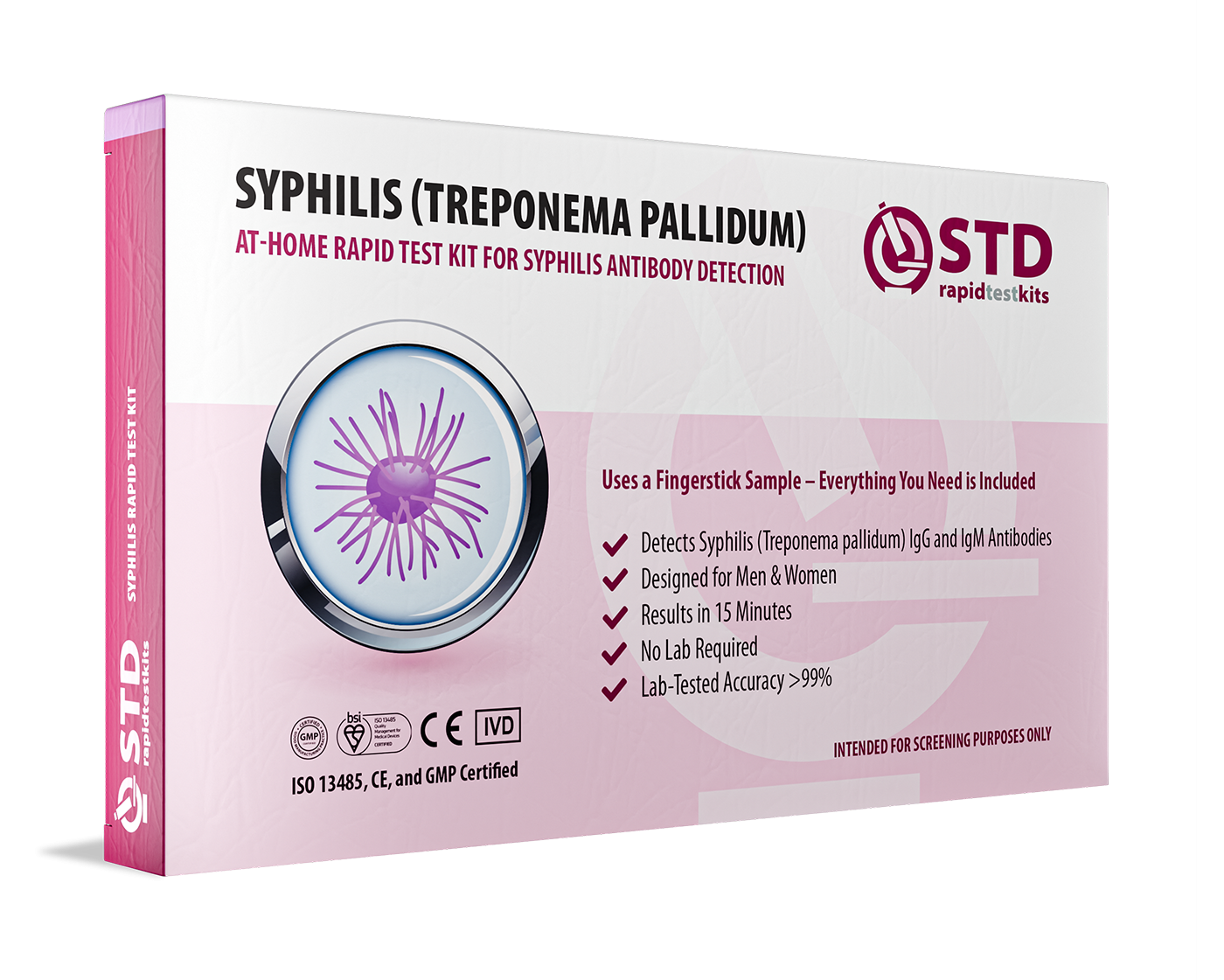Quick Answer: Nevada is seeing a surge in gonorrhea and syphilis due to delayed testing, asymptomatic spread, and strained healthcare access. At-home STD kits now offer a private, fast way to test without waiting weeks for a clinic appointment.
First came the burning. Then the blood. Then nothing at all, just a nagging sense that something wasn’t right. Dani, 33, brushed off her symptoms for weeks. “I thought it was a UTI or maybe irritation from sex. I didn’t have health insurance, and the free clinic was booked out for a month. By the time I tested, it was syphilis. I had no idea I could even get it.”
“I didn’t feel sick. I didn’t have sores. Just some weird spotting. I would’ve caught it sooner if I could’ve tested at home.”
Dani’s story isn’t unique. Nevada is facing a double threat, skyrocketing cases of both gonorrhea and syphilis, and many people are walking around infected without realizing it. According to the Nevada Department of Health and Human Services, the state has one of the highest STD rates in the U.S., with 2025 numbers surpassing even post-pandemic highs.
In Las Vegas, Reno, and rural counties alike, people are testing positive late, if at all. And in many cases, they’re waiting because clinics are overwhelmed, they’re embarrassed, or they don’t realize that modern STDs don’t always show up with “classic” symptoms.

People are also reading: Congenital Syphilis: How It Happens and How to Prevent It
What’s Fueling the Surge in Nevada?
Let’s be clear: this isn’t about “risky people.” This is about a perfect storm. Public health funding cuts. Post-COVID burnout. Record tourism. And a whole lot of silent spread.
In 2024 alone, Nevada reported:
• A 36% increase in primary and secondary syphilis cases statewide
• Gonorrhea rates rising fastest among young adults and women
• A spike in congenital syphilis (transmitted during pregnancy), according to CDC tracking data
What makes this terrifying? Many of these infections had no symptoms. Gonorrhea often presents as mild burning or discharge, if anything at all. Syphilis can masquerade as a pimple, a sore throat, or a rash that fades on its own. Most people have no idea they’re infected, and by the time they find out, they’ve passed it on or developed complications.
This is why the numbers are climbing. Not because people are “reckless,” but because we’re still testing like it’s 1999, and waiting weeks for results, if we even test at all.
Herpes Isn’t the Only Silent One: Why Syphilis Slips Under the Radar
Most people think syphilis is old news, something from textbooks or black-and-white films. But it’s very much alive. Especially in Nevada, where new infections are multiplying in men, women, and nonbinary folks across sexual orientations.
What makes syphilis dangerous is its disappearing act. After an initial sore (which might be internal or too small to notice), it vanishes. Weeks or months later, it might reappear as a faint rash, sore throat, or fatigue. Then nothing, for years. Until it attacks the nervous system, brain, or heart.
The Mayo Clinic warns that untreated syphilis can cause long-term organ damage, blindness, and even death. The good news? Caught early, it’s curable with antibiotics. But to catch it, you have to test.
Check Your STD Status in Minutes
Test at Home with RemediumSyphilis Test Kit

 For Men & Women
For Men & Women Results in Minutes
Results in Minutes No Lab Needed
No Lab Needed Private & Discreet
Private & DiscreetOrder Now $33.99 $49.00
Gonorrhea’s Growing Threat: Not Just a Discharge Anymore
If syphilis is the silent creeper, gonorrhea is its flashier cousin. Except it’s changing. Fast. And it’s not always flashy anymore.
Classic gonorrhea symptoms like burning while peeing, unusual discharge, or pelvic pain still happen, but less often than you think. Especially in women and people assigned female at birth, the infection can linger for weeks or months without any obvious symptoms. In some cases, the first sign is infertility or pelvic inflammatory disease (PID).
Even scarier? Gonorrhea is becoming harder to treat. The World Health Organization reports a rise in antibiotic-resistant strains worldwide, including in U.S. hotspots like Nevada. That means every missed case is a chance for the bacteria to mutate, spread, and outsmart meds.
The only defense is faster testing. Not in a week. Not “when you can get a ride.” Now. That’s where rapid, lab-grade test kits come in, delivered to your door, processed quickly, and totally confidential.
Why People in Nevada Aren’t Testing (Until It’s Too Late)
If you live in Vegas, Reno, or even Carson City, you might think testing is easy. Walk into a clinic. Get swabbed. Done. But the reality looks different on the ground. Clinics are backed up. Free appointments are limited. And for many Nevadans, especially those in rural counties or undocumented communities, STD testing means a two-hour drive, no privacy, and a lot of shame.
Marcus, 21, was too embarrassed to go. “I was scared they'd ask who I slept with. Or that they’d call my parents. I'm not even out. I figured if I didn’t have discharge or sores, I was fine.” He tested five months later, positive for gonorrhea in the throat and urethra. No symptoms. No signs. Just exposure he didn’t know about.
“I didn’t feel sick. But I still infected someone. That’s what hurts most.”
Marcus is one of thousands. Every year, Nevada sees a spike in STDs in people under 30, and many of them don’t know they’re carriers. Some think testing is just for “slutty” people. Others fear judgment from clinic staff or just don’t want to explain their sex life. And many, like Marcus, assume if it doesn’t hurt, it’s not there.
This is where at-home kits flip the script. No scheduling. No stares. Just you, your body, and results that could save you and your partners from long-term damage.
Not Just for One-Night Stands: Long-Term Partners Are Testing Too
Here’s a hard truth no one talks about: people in committed relationships are getting infected too. Not because someone cheated, but because someone carried something before the relationship even started. Gonorrhea and syphilis can stay hidden for months. A partner might never know they were exposed years ago.
This is why at-home tests are becoming a routine tool, not just for hookup culture, but for people in monogamous, queer, poly, and long-term relationships. It’s not about trust. It’s about transparency. A way to protect each other with facts, not assumptions.
And in Nevada’s current climate, where community transmission is rising even in “low-risk” groups, knowing your status has never mattered more. The earlier you test, the easier it is to treat, and the safer it is to love fully, without worry.

People are also reading: Can Oral Sex Cause Gonorrhea in the Throat? Signs, Risks, and Prevention
How Fast Should You Test After Sex in Nevada’s Current Outbreak?
In a perfect world, you’d test before every new partner. But in real life? It’s messy. Sometimes protection slips. Sometimes sex is spontaneous. Sometimes you trust someone, and that trust isn’t enough.
So when should you test?
For gonorrhea and syphilis, most infections can be detected within 1–3 weeks after exposure. That means if you had a new or untested partner this month, testing now is smart. If you’ve had ongoing symptoms for longer, even better; it increases detection accuracy. If your last test was months ago, you could be positive without knowing it.
Waiting for symptoms isn’t enough. Gonorrhea can sit in your throat or rectum silently. Syphilis can vanish and return. You don’t need to be sick to be contagious. And the longer these infections go untreated, the more damage they can cause, especially in the nervous system, reproductive organs, and immune system.
You Can Test Without Leaving the House
This isn’t 1995. You don’t need to beg for an appointment, take time off work, or explain your sex life to a stranger to get answers. You can test from home.
STD Rapid Test Kits offers FDA-approved, lab-verified combo kits that test for gonorrhea, syphilis, and more. They’re shipped discreetly, processed quickly, and don’t require you to say a single word about what you’ve done or who you’ve done it with.
Whether you’re in a Vegas high-rise or rural Lyon County, you deserve access. Testing isn’t about morality. It’s about your immune system. Your future. Your peace of mind.
Check Your STD Status in Minutes
Test at Home with Remedium3-in-1 STD Test Kit

 For Men & Women
For Men & Women Results in Minutes
Results in Minutes No Lab Needed
No Lab Needed Private & Discreet
Private & DiscreetOrder Now $69.00 $147.00
For all 3 tests
Still Not Sure? That’s Normal.
You might still be debating. You might be afraid of the result. That’s okay. Testing doesn’t mean you’ve done something wrong. It means you’re doing something right, something most people avoid until they’re already sick or scared.
The truth is, most STDs are treatable. But only if you catch them. In a state where numbers are surging, waiting doesn’t help. Worry doesn’t fix it. But knowledge? Knowledge changes everything.
Your partner doesn’t need to know you ordered a kit. Your boss doesn’t need to approve time off. You can handle it on your own time, in your own way. And if it comes back negative? Relief. If positive? A clear next step.
This isn’t just about protection. It’s about power. And in Nevada right now, power means testing sooner, not later.
FAQs
1. Why are there more cases of gonorrhea and syphilis in Nevada?
Picture this: you’ve got a city that never sleeps, millions of tourists passing through, and a health system that’s been running on less and less public funding. Add in the fact that both gonorrhea and syphilis can slip by without obvious symptoms, and you’ve got a perfect storm. People don’t get tested because it’s harder to find a clinic, or they don’t even know they’re carrying it. The infections keep moving quietly from person to person.
2. Is it possible to have gonorrhea or syphilis and not know it?
Absolutely. In fact, it’s common. Think of them as the “ghost” STDs, sometimes there’s no fever, no discharge, no pain. You can go weeks or months feeling totally fine, meanwhile the bacteria are doing their thing. That’s why they spread so easily, it’s not always the people with obvious sores who pass them on.
3. How long should I wait to take a test after having sex without protection?
The sweet spot for catching syphilis or gonorrhea in a test is usually between one and three weeks after you might have been exposed. It’s like catching a photo when the culprit finally steps into frame, test too early, and the bacteria might not be detectable yet. If you’re feeling symptoms, don’t delay. If you’re not, waiting that window can make your results more reliable.
4. Do STD tests you do at home work?
The short answer? Yes, if you use the right kind. The at-home kits from STD Rapid Test Kits are FDA-approved and processed in certified labs, so they’re as accurate as what you’d get in a clinic. The catch: you’ve got to follow the instructions exactly. This isn’t IKEA furniture, there’s no winging it with an extra screw left over.
5. Can you still get rid of syphilis?
You can, if you catch it early. A simple round of penicillin or another prescribed antibiotic usually wipes it out. But syphilis is like an unpaid bill, the longer you ignore it, the more expensive it gets. Left untreated, it can damage your brain, heart, and nerves.
6. What happens if antibiotics don’t work on gonorrhea?
That’s when doctors pull out the big guns. Some strains are becoming resistant to the usual meds, which is why catching and treating them early matters so much. Think of it as stopping a rumor before it goes viral, once it spreads too far, it’s a lot harder to control.
7. Should I go to a clinic to get tested?
Not always. If you’re in a small town, don’t have a ride, or just don’t want to sit in a waiting room wondering if the receptionist is judging you, an at-home test can be a lifesaver. You swab, send, and get results privately, without ever seeing a clinic door.
8. What are the first things that happen when you get syphilis?
Usually, you’ll spot a single sore that doesn’t hurt, the kind you might ignore because it’s painless. It can show up on your genitals, anus, or even inside your mouth. Later, rashes can appear on your body (including your palms and soles), along with flu-like symptoms. It’s sneaky and changes stages if you don’t stop it early.
9. Do STDs have an effect on fertility?
Yes, and it’s one of the most heartbreaking parts. Untreated gonorrhea or syphilis can cause pelvic inflammatory disease, which can block fallopian tubes, damage reproductive organs, and even cause pregnancy complications. I’ve seen couples struggle for years because of an infection they never knew they had in their 20s.
10. Is it safe to use tests at home in rural areas?
Definitely. Kits arrive in plain packaging, and as long as you can get mail, you can get tested. For some people, especially those hours away from the nearest clinic, it’s the only realistic way to stay on top of their sexual health without turning it into a full-day trip.
This Isn’t About Fear, It’s About Freedom
You’re not overreacting. You’re not being paranoid. You’re paying attention, and that could protect your body, your partners, and your future. Nevada’s STD rates are rising fast, but you’re not powerless. Whether it’s your first test or your fifteenth, whether you have symptoms or just a hunch, testing is the most powerful choice you can make today.
Sources
1. CDC – National Overview of STIs 2023
2. CDC/MMWR – Missed Opportunities for Congenital Syphilis Prevention in Nevada (2022)
3. CDC – Table 28: Chlamydia Rates by State (2023)
4. Southern Nevada Health District – STI Awareness Week Updates & Local Data (2024–2025)










